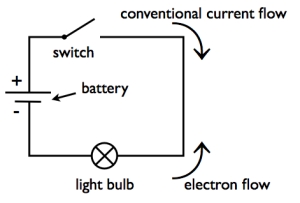Electric Current
Electric current is the flow of charge. The SI unit of current is the Amp. [A].
In mathematical terms we can describe the current as the rate of change of charge with time.
I = dQ/dt.
In order for the charge to flow there has to be a potential difference. V.
Microscopic Description
To produce a current the charge needs to flow in a conductor. This charge is carried by electrons. Consider a section of wire of length l and cross-section A, in which there is a potential difference. Electrons flow from the higher potential to the lower potential.
The total charge per unit volume = n
Therefore the total charge is dQ = nqAl, since Al is the volume of the wire and q is the charge on the electron.
If the electrons are moving at a speed vd. Then dt is l/vd seconds for the electrons to pass the point X.
The current I = dQ/dt = nqAvd
Free Electron Density
To calculate the number of electrons per unit volume in a metal we need to know some basic data such as the molar mass of the metal, density, the number of free electrons or valancy.
n = ρNA/M
If we know the current I and the number of electrons n we can calculate the drift-velocity. vd.
The drift-velocity is actually only around a millimeter per second.
For example, a current of 1 A at 6 V, how many electrons pass per second in a copper wire,
Conventional Current
One of the confussing aspects of current is the direction in which the current flows. It is an accident of history that the current was a flow of positive charge carriers. However, in metal conductors, the positive ions are not able to move and the flow of charge is a result of negative electrons. As a result the true direction of the current flow is in the opposite direction to the conventional current. It does not matter which is used as long as you are consistent.
To make it absolutely clear:

- The conventional current flows from positive to negative.
- The electron flows from negative to positive.
